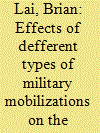| Srl | Item |
| 1 |
ID:
052177


|
|
|
|
|
| Publication |
April 2004.
|
| Summary/Abstract |
One dominant explanation for why crises escalate to war is based on misperception. Alternative rational explanations for why crises escalate to war are examined, including commitment problems, the cost of revealing military advantages, and a desire for greater future gains. These explanations for war argue that states are likely to prefer a military to a diplomatic solution and to mobilizetheir militaries to maximize a surprise attack advantage. This type of mobilization (private) is different from mobilization by states seeking a diplomatic advantage (public) because states are trying to avoid revealing information. When one state in a crisis mobilizes privately, war is more likely because one state is committed to conflict whereas the other is not receiving signals of an impending conflict. The effect of private mobilization on war is tested using the International Crisis Behavior data. The results demonstrate that private mobilization is likely to lead to war.
|
|
|
|
|
|
|
|
|
|
|
|
|
|
|
|
| 2 |
ID:
165258


|
|
|
|
|
| Summary/Abstract |
Theories of crisis bargaining suggest that military mobilizations act as costly signals of resolve, increasing the credibility of coercive threats. In this article, I argue that air mobilizations, as a subset of military signals, demonstrate a lack of resolve during coercive bargaining for four reasons: they cost less in terms of human and financial resources (sunk costs), generate lower political costs (hand-tying), do not raise the risks of engagement (manipulation of risk), and do not significantly shift the balance of power—all compared with other military signals. Using new data that disaggregates military demonstrations into air, naval, and land signals during 210 cases of compellence, this article presents systematic evidence that air signals decrease the probability of coercive threat success compared with the alternatives. This finding holds important implications for theoretical and policy debates regarding the role of costly signals in international bargaining.
|
|
|
|
|
|
|
|
|
|
|
|
|
|
|
|
| 3 |
ID:
164269


|
|
|
|
|
| Summary/Abstract |
Relying on a wide range of sources, this article examines the implementation of mobilization plans by state, military, and local authorities of Siberia during the mobilization campaigns of the summers of 1914 and 1941. It reveals the consistent pattern of difficulties encountered by Siberian military districts when attempting to fulfill mobilization plans over the periods of World Wars I and II.
|
|
|
|
|
|
|
|
|
|
|
|
|
|
|
|
| 4 |
ID:
167444


|
|
|
|
|
| Summary/Abstract |
The actual size of Bulgarian medieval armies, reputedly among the largest and most successful European armies of the day, has continued to interest historians, but serious studies have generally relied on evidence drawn from a handful of specific events. This article aims to ascertain army size from a survey of Bulgarian medieval military history. It will provide a critical overview of army size during the entire medieval period, from the First Bulgarian Empire (681–1018) through the Second Bulgarian Empire (1185–1422), as the country evolved from a semi-nomadic state into a centralized empire whose armies were able to hold their own against their regional foes, particularly the more powerful Byzantine Empire.
|
|
|
|
|
|
|
|
|
|
|
|
|
|
|
|